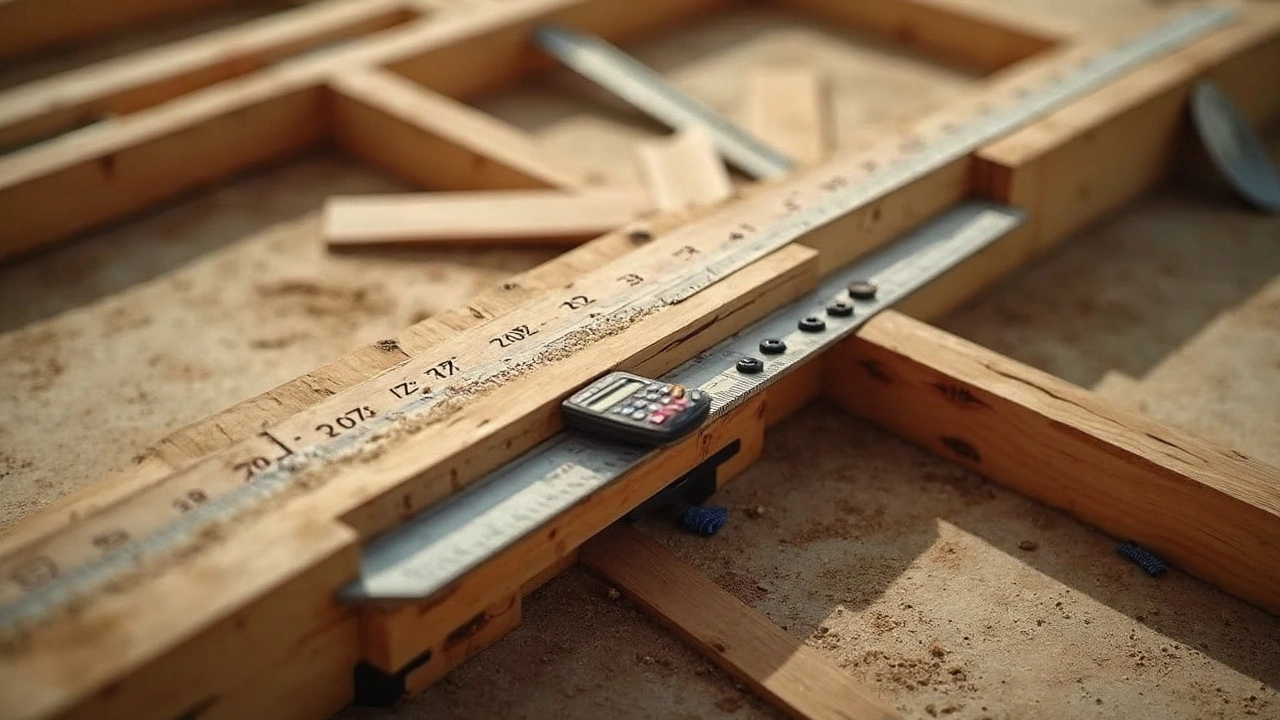Ever wondered how builders make sure those walls meet up perfectly at a right angle? Trust me, it's not just luck or a good eye. The secret weapon here is the 3 4 5 method, a straightforward construction trick based on the Pythagorean theorem. This method is all about creating a triangle with sides measuring 3, 4, and 5 units, and bam! You've got yourself a perfect 90-degree angle.
The beauty of the 3 4 5 method is that it doesn't require any high-tech tools or complex calculations. It's as easy as 1-2-3, literally. Grab a tape measure, some string, and a couple of stakes, and you're ready to roll. This technique is especially handy in commercial construction, where precision is key.
Why is this important, you ask? Well, getting those corners right can make or break the whole project. Misaligned walls can lead to structural issues down the line. Plus, it helps avoid awkward 'oops' moments when your forms or frames just don't fit as they should. So, knowing how to apply this method can make a huge difference in the quality and accuracy of your build.
- What is the 3 4 5 Method?
- How to Apply the Method in Construction
- Benefits of Using the 3 4 5 Method
- Tips for Accurate Implementation
What is the 3 4 5 Method?
The 3 4 5 method is a tried-and-true technique used by builders to ensure that they create accurate right angles on a construction site. This method stems from the Pythagorean theorem—remember that thing from math class involving triangles?—where a squared plus b squared equals c squared. In our case, 'a' is 3 units, 'b' is 4 units, and the hypotenuse 'c' is 5 units, which makes a neat right angle triangle every time.
So why is this method such a big deal in commercial construction? Simple—it helps contractors make sure their building angles are perfectly square. When you're laying out the foundations for a building, making sure corners are exactly 90 degrees prevents future headaches with walls not aligning or floors being wonky.
To use the 3 4 5 method, you just need basic tools: a tape measure, some stakes, and string. The technique goes like this:
- Step 1: Mark a point on the ground where you want to start your layout.
- Step 2: Measure 3 units out along one side and make a mark (this is 'a').
- Step 3: From the same starting point, measure 4 units along another side and make another mark (this is 'b').
- Step 4: Connect these two points with a string. If the distance between them is exactly 5 units (this is 'c'), you've nailed that 90-degree angle!
It's like an old-school pocket calculator but way more practical in the field. The simplicity and precision of the 3 4 5 method make it a cornerstone in the toolkit of anyone serious about building right. So next time you see a perfectly squared building, there's a good chance this little trick played a part.
How to Apply the Method in Construction
Alright, now let's get into the nitty-gritty of applying the 3 4 5 method in building construction. It’s all about creating a precise right angle using this easy triangle method. Here’s how you can do it:
First, you’re going to need a few simple tools: a tape measure, some string or chalk, and a couple of stakes. Got them? Great, let’s move on.
- Mark the Baseline: Using your tape measure, mark the first side of your triangle—this is the 3-unit side. Secure one end with a stake.
- Measure the Perpendicular Line: From your initial stake, measure 4 units to create the second side of the triangle, marking it with another stake.
- Complete the Triangle: Now measure a diagonal line from the second point to the end of the 3-unit line you first laid out. This should measure exactly 5 units if everything is spot-on.
When the diagonal is exactly 5 units, congrats! Those first two lines form a perfect right angle, thanks to the trusty old Pythagorean theorem.
The beauty of the 3 4 5 method is not just its simplicity but also its adaptability. Whether you’re setting up forms, laying foundations, or even checking the squareness of a large field, this trick gets the job done.
A quick tip: If you’re working on a larger scale, just multiply these numbers up. So, think 6, 8, and 10 feet, or even larger. The same idea applies, just scaled up for bigger projects.
Take it slow the first few times until you get the hang of it, but once you do, it’s a total game changer for your commercial construction projects. Getting those angles right from the get-go can save a lot of headaches later on!

Benefits of Using the 3 4 5 Method
The 3 4 5 method is like the trusty Swiss Army knife of construction tricks. Its simplicity and effectiveness make it a favorite, especially in commercial construction. One of the biggest perks is accuracy. By ensuring perfect right angles, this method helps builders avoid structural nightmares and keeps everything aligned just right.
Another great advantage is its cost and time efficiency. You don't need fancy gadgets or digital equipment. A tape measure, some stakes, and a bit of string are all it takes. This method saves money by reducing the need for corrections down the road, which can be really expensive and time-consuming.
Besides saving time and money, using this method can reduce material waste. Think about it: when corners are spot-on, everything else falls into place. No more battling with skewed angles that force you to adjust and waste resources.
Plus, it's a universal tool that's easy to teach and learn. Whether you're new to the trade or have been at it for years, anyone can quickly grasp and apply the 3 4 5 method. It’s a skill that improves the overall quality of construction and gives peace of mind knowing that your angles are as reliable as they get.
Check out how this method stands out in some numbers:
| Benefit | Impact |
|---|---|
| Time Savings | Up to 20% faster setup for right angle measurements |
| Cost Reduction | Eliminates up to 15% of errors related to misalignment |
So, when you're knee-deep in a project and need to ensure everything is lined up perfectly, the 3 4 5 method definitely becomes your best friend.
Tips for Accurate Implementation
Getting the 3 4 5 method right is a game-changer in building construction. Here are some handy tips to nail it every time. Start by choosing the longest tape measure you’ve got; the longer it is, the more accurate your triangle will be.
First up, always mark your points clearly. Use bright, durable markers or spray paint to clearly define where your points are, especially if you're working on a large site. Double-check these marks from different angles to ensure they line up perfectly.
Here's a simple step-by-step to go by:
- Measure and Mark: Start by marking one side of your right angle, say 3 feet. Then, mark another line perpendicular to this measuring 4 feet.
- Verify the Diagonal: Measure between the endpoints of these two lines. The distance should be exactly 5 feet. If not, adjust until it is.
- Lock It In: Once your triangle checks out, lock the points in place using stakes or similar. This forms a reliable guide for your construction.
Another crucial tip: avoid stretching the measuring tape. Even a little slack can throw off your measurements. Keep it taut, and maybe grab a buddy to help hold it steady. Also, working on a calm day can help, as strong winds might interfere with your setup.
It's not just about how you measure—striking a balance between speed and precision is key. Rather than rushing through the setup, take a few extra minutes to double-check each measurement. This ensures you won’t face costly fixes later.
In the complex world of commercial construction, efficiency matters. Research shows that a third of costly on-site corrections are due to incorrect alignment setups. By adopting the 3 4 5 method carefully, you could avoid joining that statistic.
